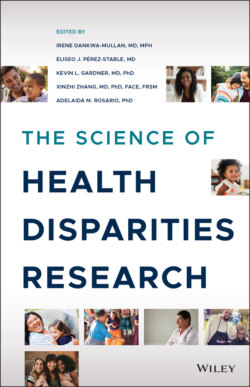Читать книгу The Science of Health Disparities Research - Группа авторов - Страница 36
2.5 Sleep
ОглавлениеSleep is an essential human need for maintaining biological homeostasis. It plays an important role as both a mediator and downstream measure of allostatic load. Defined as “a recurring, reversible neuro‐behavioral state of relative perceptual disengagement from and unresponsiveness to the environment” [33] with complex behavioral and physiological processes, it normally begins in a light stage of Non‐Rapid Eye Movement (NREM) sleep and progresses into deeper periods of NREM over approximately 90‐minute cycles. NREM sleep typically comprises 75% of the sleeping period [34]. The remaining period consists of Rapid Eye Movement (REM) sleep, which is characterized by increased brain activity causing the eyes to dart back and forth [35]. Based on polysomnographic measures of the neurophysiological signal's frequency and amplitude, the various sleep stages are associated with particular health benefits. For instance, slow wave (also known as deep sleep or “N3”) is considered the most physiologically restorative stage of sleep [35]. In addition to other physiological processes, cellular and tissue growth as well as repair occurs in this stage. The metabolically active hormones referred to previously are also released. During this stage, blood pressure also customarily drops. Breathing tends to slow. Regarding REM sleep, this stage has been associated with restoration of cognition, which is important for learning, consolidating memories, and regulating emotions [36].
While sleep needs vary by age group, the National Sleep Foundation recommends that adults need between seven and nine hours of quality, uninterrupted sleep with minimal arousals for sleep to be fully restorative, and for maintaining and promoting optimal health [37]. Some data suggest that the mean sleep duration of persons in the United States has decreased over time. Estimates indicate that American adults are getting an average of 6.1 hours of sleep per day independent of quality [38] and sleep deprivation annually costs the US economy approximately $411 billion [39]. An estimated 60 million prescriptions for sleeping pills are written per year and more than 300,000 automobile accidents occur, with 6400 of them being fatal, that are largely attributed to the under‐recognized phenomenon of drowsy driving, which results from sleep deprivation [40]. Unfortunately, approximately 50 to 70 million US adults have sleep or wakefulness disorders, such as obstructive sleep apnea (OSA), insomnia, narcolepsy, and restless leg syndrome. In 2006, sleep was considered an unmet public health need by the Institute of Medicine [41]. The Department of Health and Human Services also established Healthy People 2020 goals to increase the proportion of Americans getting sleep in recommended amounts.
Poor sleep (or insufficient sleep quantity and/or inadequate quality relative to what is needed for optimal performance as well as physical and mental/emotional health) is a gateway to numerous conditions linked to rising allostatic load and increased risk of suboptimal chronic health conditions, such as obesity, hypertension, type 2 diabetes, cardiovascular disease, and premature mortality [42]. In terms of potential biological mechanisms, partial sleep deprivation is believed to influence hormonal and growth factor signaling to the hypothalamus. For instance, sleep deprivation has been shown to downregulate leptin (a hormone associated with satiety) and upregulate ghrelin, a hormone associated with increased hunger [42]. The combined action of these hormones has considerable influence on the development of a host of chronic health conditions (e.g., obesity, type 2 diabetes). Additionally, hyperarousal of certain brain regions related to sleep deprivation is associated with hedonistic behaviors like sweet/salty food cravings. Furthermore, sleep disturbances often precede the onset of mood disorders, like anxiety and depression, which, for instance, exacerbate risk factors for suicide and depression relapse [43].
